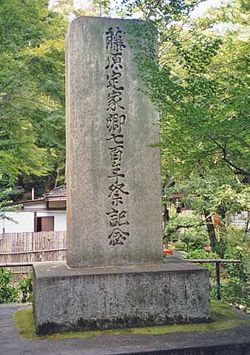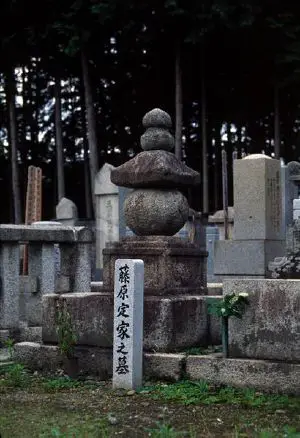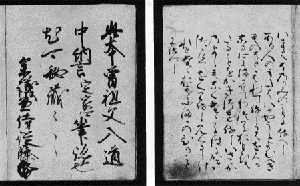Fujiwara no Teika

Fujiwara no Teika or Sadaie (藤原定家 Fujiwara no Teika (the characters 定家 can also be read Sadaie); 1162–September 26, 1241) was a Japanese waka poet, critic, calligrapher, novelist (Tale of Matsura), scribe and scholar of the late Heian and early Kamakura periods. His influence was one of the strongest and he is even to this day counted among the greatest of Japanese poets, and perhaps the definitive master of the waka form. His ideas on composing poetry were final until perhaps as late as the Meiji era.
Biography
Teika was born to the aristocratic and courtly poetry specialist clan, the Fujiwara, in 1162. His father was Fujiwara Shunzei, who was already well known and respected as a poet- he had compiled the seventh Imperial anthology of waka, and his grandfather was the respected poet Fujiwara no Toshitada. Teika's goals were to cement his father's position in poetry, advance his own reputation, and to thereby also improve the political fortunes of his own clan in the court. While his life would be marked by repeated illness and wildly shifting fortunes- only partially moderated by his father's influence (Shunzei would live to the age of 90) in court- the young and poetically inclined Retired Emperor Go-Toba's patronage would prove to lead to some of Teika's greatest successes, such as being appointed by Go-Toba a compiler (and de facto head compiler by virtue of his dedicatedness and force of personality in addition to his already established reputation as a poet) of the eighth Imperial Anthology of waka poetry, the Shin kokinshu (~1205, "New Collection of Ancient and Modern Times") which Go-Toba ordered to be written. As if the honor of helping to compile it and having a number of his poems included were not enough, Teika was appointed in 1232 to compile- by himself- the ninth Imperial Anthology, the Shin chokusenshu (~1235; "New Imperial Collection"). To this day, Teika is the only person to have ever been a compiler of two Imperial Anthologies.
This favorable patronage and collaboration soured, partially over differences in how many top-notch poems to include in the anthologies (some strains of poetic thought at this period called for poems lesser brilliance to favorably offset the more brilliant; Teika differed from them and Go-Toba, striving to make the entire anthology excellent.) and personality conflicts; possibly a factor in this estrangement was politics- Teika had the good fortune of being selected (1209) as a poetry teacher to the new and young shogun, Minamoto Sanetomo. It was probably to the unhappy Sanetomo that Teika addressed the prefatory essay to his didactic collection, "Superior Poems of Our Time", and his treatise on poetry Maigetsusho. Go-Toba would become an enemy of the bed-ridden Teika. Fortunately for Teika, Go-Toba would be exiled by the Kamakura shogunate in 1221 for the rest of life to the Oki Islands after the Jokyu War; his political fortunes improved in this period, as it was after Go-Toba's exile that Teika was appointed compiler of the Shin chokusenshu, and that Teika advanced at the age of 70 to the court rank of "Acting Middle Counselor" (Gon Chūnagon).
He died in 1241, in Kyoto, and was buried at a Buddhist temple called Shokokuji. One of his two sons, Fujiwara no Tameie, would carry on Teika's poetic legacy.
Poetic achievements
He selected the works for the Ogura Hyakunin Isshu, an anthology of a hundred poems by a hundred poets. His Hyakunin Isshū was later thought a book of waka theory in which all types of ideal waka and all techniques were laid out; disputes over specific style and whether to be conservative or liberal divided his descendants into a number of feuding schools/clans like the Reizei, Kyogoku, and Nijo.
Teika made many manuscripts of Japanese classics, including such landmarks of Japanese literature as The Tale of Genji, The Tales of Ise and the Kokinshu anthology. In his days, the ancient Japanese pronunciations had been lost, rendering the orthography of kana confused and uncertain. Teika researched old documents and recovered the earlier system of deciding between kana, and made a systematic orthography. It was used until the modern period. He applied his kana system to his manuscripts. His manuscripts were known for their accuracy and good quality and called Teika bon (Teika text). Using his method he was able to document the accurate pronunciation of earlier waka like Kokin-wakashū.
His manuscripts were also appreciated for his distinct and bold eponymous style of calligraphy.
Teika is also remembered, like his father, as being something of an innovator- the Encyclopedia Britannica says:
- "Teika employed traditional language in startling new ways, showing that the prescriptive ideal of "old diction, new treatment"inherited from Shunzei might accommodate innovation and experimentation as well as ensure the preservation of the language and styles of the classical past."
His poems were described as remarkable for their elegance and exemplar of Teika's ideals, in his early and later years (respectively; Teika considerably modified his personal beliefs during his 40s, and simplified his style of composition), of the styles of yoen (a style concerned with "ethereal beauty") and ushin ("deep feeling" or "conviction of feeling"). His yoen style was most popular in this time, and years later, the Symbolists would admire and emulate (to a degree) his use of language to evoke atmosphere in his brief poems in the yoen style.
| Japanese | English |
|
|
|
| |
|
|
Partial bibliography
- Eiga taigai (~1216, 1222?; "Essentials of Poetic Composition")
- Hyakunin isshu (~1235 "Single Poems by One Hundred Poets"; interestingly, this collection would become the base of the modern Japanese New Year game karuta.)
- Hyakunin Shūka (1229-1236?; an 101 poem anthology arranged at the request of Utsunomiya Yoritsuna to be copied onto 101 strips of paper and pasted onto the walls of his villa; it has 97 poems in common with Hyakunin isshu, leading to the suggestion that perhaps it is a mis-indentified and corrupt version of the Isshu.)
- Kindai shūka (~1209; "Superior Poems of Our Time"; a collection of poems Teika felt to be excellent models, with a preface dealing with his critical philosophy, sent to Sanetomo to instruct him in how his poems should emulate the great ancient Japanese poets- teaching by example.)
- Maigetsusho (~1219; an epistle of corrections of one hundred poems, sent to a student of Teika's; Shotetsu states that it was sent to Sanetomo; Ton'a holds rather that it had been sent to the "Kinugasa Great Inner Minister", or Fujiwara Ieyoshi.)
- Matsura Monogatari ("The Tale of Matsura"; an experimental novel believed to be written by Teika, though Teika's manuscript claims he was merely copying it.)
- Meigetsuki ("The Record of the Clear Moon"; diary)
- Nishidaishū (Anthology of 1811 poems from the first 8 Imperial anthologies.)
- Shuka no daitai ("A Basic Canon of Superior Poems")
- Teika Jitte (1207-1213; an anthology of 286 poems, chiefly derived from the Shinkokinshu; long believed a forgery, but some modern scholars contend that it is a genuine work.)
ReferencesISBN links support NWE through referral fees
- Fujiwara Teika's Superior Poems of Our Time, trans. Robert H. Brower, Earl Miner. 1967, Stanford University Press, L.C. 67-17300, ISBN 0-804-70171-7
- Hyakunin-isshu (Single songs of a hundred poets) and Nori no hatsu-ne (The dominant note of the law), editted by Sadaie Fujiwara, translated into English by Clay MacCauley. Published in Yokohama, Shanghai by Kelly and Walsh, Ltd. 1917. OCLC 10905811
External links
- Brief biography of Teika and links to ~41 translated poems.
- Entry at Encyclopedia Britannica
- Hyakunin isshu -(Public domain translation online)
- Page on the Meigetsuki
- Picture of a portion of a handscroll of the Meigetsuki
ja:藤原定家
Credits
New World Encyclopedia writers and editors rewrote and completed the Wikipedia article in accordance with New World Encyclopedia standards. This article abides by terms of the Creative Commons CC-by-sa 3.0 License (CC-by-sa), which may be used and disseminated with proper attribution. Credit is due under the terms of this license that can reference both the New World Encyclopedia contributors and the selfless volunteer contributors of the Wikimedia Foundation. To cite this article click here for a list of acceptable citing formats.The history of earlier contributions by wikipedians is accessible to researchers here:
The history of this article since it was imported to New World Encyclopedia:
Note: Some restrictions may apply to use of individual images which are separately licensed.



